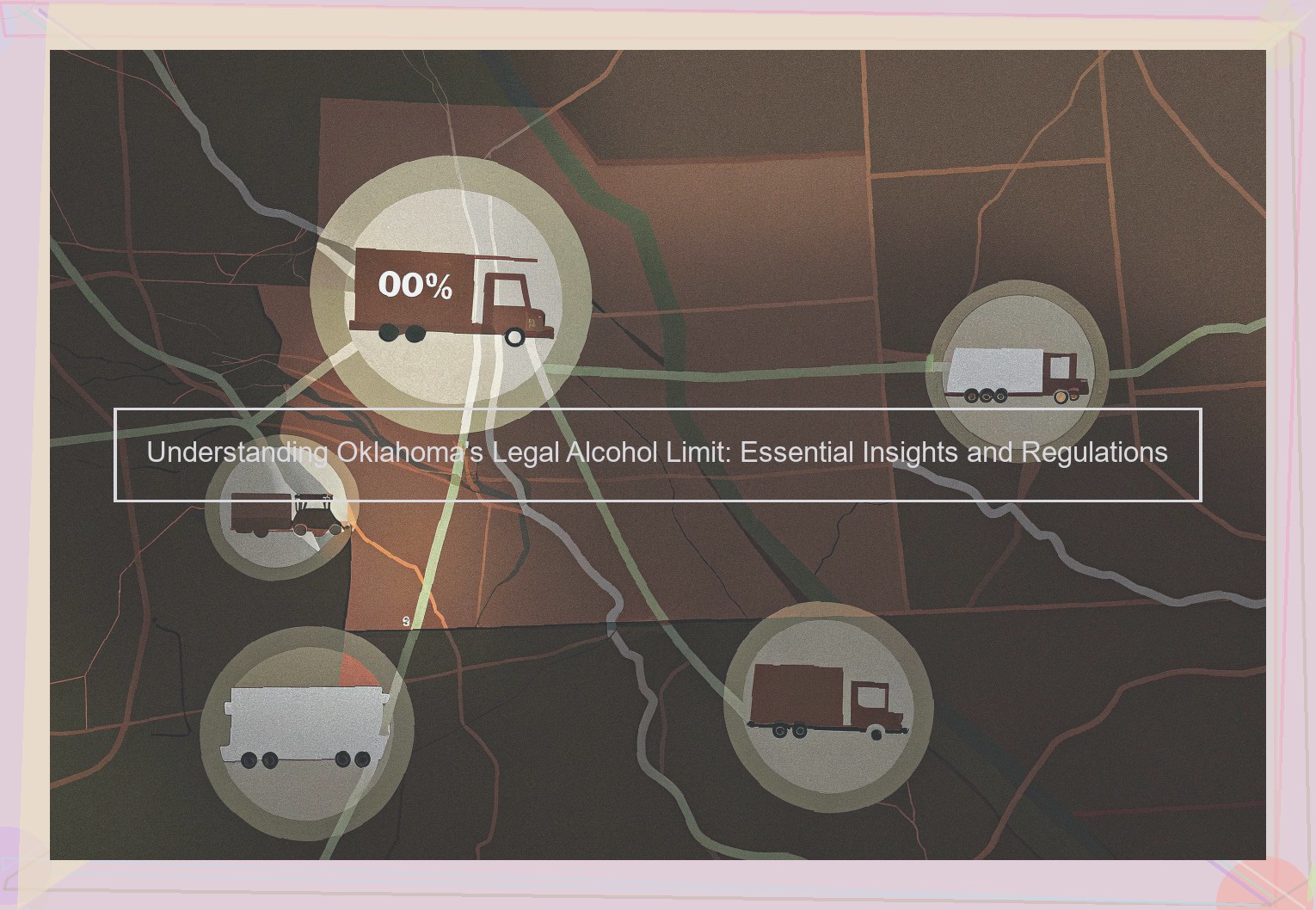Oklahoma’s Legal Alcohol Limit Explained
Under Oklahoma state law, the legal alcohol limit for drivers is set to a Blood Alcohol Concentration (BAC) of 0.08%. This number has been standardized nationally, following the federal government’s recommendations on BAC limits for drivers. These recommendations set the standard for adult commercial and noncommercial drivers.
This limit does not, however, apply to all classes of driver in Oklahoma.
Oklahoma legal limit for adults
Because the federally-recommended BAC of 0.08% does indeed comport with Oklahoma state law, this is the limit for alcohol consumption for commercial and non-commercial adults ages 21 and older who drive vehicles on public roads.
Oklahoma legal limit for minors
Since those under the age of 21 are prohibited by law from consuming alcohol, any amount of alcohol will result in a citation for driving under the influence (DUI).
Oklahoma legal limit for commercial drivers
Commercial drivers in Oklahoma are subject to a lower BAC limit than the federally-mandated 0.08%. While 0 . 08% is indeed the limit for all commercial drivers except those who are required to operate a commercial vehicle under the influence of alcohol, the law is stricter with those who drive commercial vehicles containing an alcohol concentration of 0.04% or greater.
Oklahoma legal limit for school bus drivers
Drivers whose commercial class includes a school bus endorsement are subject to even stricter legal limit regulations. These individuals may not operate a vehicle that carries more than 15 passengers with a BAC greater than 0.02%. This means that a BAC of 0.02% will result in a citation for school bus drivers, but commercial drivers who are not operating school buses can be cited only when their BAC is 0.04% or greater.
Penalties for violations of BAC levels
Violators of Oklahoma’s BAC laws are subject to a variety of penalties, depending in part on their age, the type of vehicle they were driving and the state in which they committed their infractions. The penalties may include driver’s license suspension, community service, fines and even jail time in some cases.
Penalties for Driving Over the Legal Limit
As with other states, the consequences of exceeding the legal alcohol limit in Oklahoma can be serious and far-reaching. When individuals are pulled over for suspected DUI, their blood alcohol content may be tested using a breathalyzer or a blood test. Those who exceed the .08% legal limit may expect both immediate and long-term consequences.
One of the most damaging immediate consequences is an administrative driver’s license action. Generally, also known as an ADSA, this means that a person’s driving privileges may be suspended by the Oklahoma Department of Public Safety if they test above the legal limit. This administrative action may happen before any legal action is taken or even if a person has not been convicted of a DUI in criminal court. This administrative driver’s license action is typically taken immediately upon arrest, and it takes effect within 30 days. The suspension of driving privileges generally lasts for 90 days to one year, depending on the specifics of the case.
One of the most common criminal penalized DUI consequences in Oklahoma is a fine of up to $1,000. In addition to a fine and conviction, Oklahoma DUI laws may require an Ignition Interlock Device for all repeat offenders. DUI convictions in Oklahoma may also be subject to counseling. Multi-level or repeat DUI convictions and punishments may result in prison time and mandatory fines of up to $5,000. In certain DUI cases, a driver’s license suspension may be permanent. This decision is left to the judge’s discretion and may apply for a third DUI or any repeat DUI conviction thereafter.
How Blood Alcohol Concentration is Influenced
Several variables enter into BAC (Blood Alcohol Concentration) as well, such as gender and body weight. The amount of alcohol in a given person’s blood is not always determined by how much he or she drinks. Gender plays a role in BAC because women tend to have higher values since they weigh less than men and have smaller amounts of the enzyme that expels alcohol from their bodies. The enzyme is found primarily in the stomach.
Body weight comes into play, too. For instance, someone who weighs 150 pounds will take longer to reach the legal limit of 0.08 percent than someone who weighs 300 pounds after carpools, happy hours, dinner parties and other events have highlighted various occasions for good cheer.
Metabolism often trumps all other factors when it comes to the effects of alcohol on people. The liver can only process a certain amount of alcohol with its enzymes. When that level is reached, one drinks too much too quickly. Even with food in the stomach, no more alcohol can be broken down. It then spreads through the rest of the body and affects all parts until it gets to the brain and causes intoxication.
For persons participating in recreational drinking, their obedience to the law could depend on how much they weigh and the amount of enzymes they have in their livers.
Ways to Stay Below the Legal Limit
When it comes to drinking alcohol and staying within the legal limit, moderation is key. The average person can metabolize about one standard alcoholic drink per hour. If you have any doubts, consider getting a portable breathalyzer to measure your blood alcohol content (BAC). Any BAC over .08 percent is considered driving under the influence in Oklahoma . Fortunately, it’s possible for the average person to look at their BAC and make an informed decision about whether they are sober enough to drive. That said, a driver with diminished capacity could still get arrested with a BAC under .08 percent. Refrain from drinking with the intention of driving. If you plan to drink, also plan to either stay the night or hire alternate transportation. A taxi or ride-share service can also keep you safe and out of trouble.
How the Legal Limit Laws Impact the Roads
In the realm of traffic safety, the legal limit for blood alcohol concentration (BAC) plays a pivotal role in safeguarding against the tragic consequences of drunk driving. By establishing a clear threshold for impairment, it becomes easier for law enforcement to penalize offenders and accurately assess the culpability of drivers involved in a crash. However, the implications of these legal standards extend beyond mere adjudication.
Research suggests a strong correlation between BAC limits and decreased rates of alcohol-related accidents. For instance, the National Highway Traffic Safety Administration (NHTSA) has reported that nations that have adopted lower legal limits for BAC reduction, have seen a decrease in the rates of alcohol-related traffic fatalities. In some countries, where the legal BAC is less than the 0.08 g/dL standard set in the United States, the incidence of fatal crashes is significantly lower when compared to statistics in the U.S.
Within the United States, the impact of legal BAC limits is notably prominent. Since the implementation of the 0.08 g/dL federal legal limit over the past two decades, there has been a marked reduction in the prevalence of drunk driving. According to the NHTSA, the percentage of drivers in fatal motor vehicle crashes with BACs of 0.08 g/dL or higher fell from 15% in 1990 to less than 10% in 2016. Furthermore, widespread awareness campaigns and the ubiquitous nature of devices such as Breathalyzer testing kits and breath analyzers have armed both law enforcement and the public with the tools needed to identify and deter individuals who engage in impaired driving.
Additional studies into the impact of BAC limits reveal that public policy has a tangible effect on real-world behavior. Canadian data, for example, has shown a steady decline in the number of impaired-related fatal collisions in the 0.05 g/dL range following the enactment of Ontario’s "zero-tolerance" drinking and driving law in 2018. In addition, individual states such as Oklahoma have regularly reviewed and revised their laws to align with up-to-date research into the impacts and risks associated with alcohol consumption while driving.
The progressive evolution of legal alcohol limits within the United States and abroad shows that these laws significantly influence reductions in motor vehicle crashes. When paired with corresponding preventative measures, such as random breath testing, education campaigns, and public transportation, they create a multi-pronged approach to reducing the risk of drunk driving. While it is impossible to entirely eliminate this threat, the continued enforcement of legal alcohol limits represents an effective strategy for lowering the rates of alcohol-related crashes.
Legal Resources and Help
When facing charges of violating the legal alcohol limit in Oklahoma, it is crucial to seek helpful legal resources. Whether you are charged with driving under the influence or another alcohol-related offense, finding the right legal representation can help you alleviate potential penalties, especially when charged with a crime. The first step in seeking legal assistance is finding an attorney. Not all attorneys work on cases that involve the legal alcohol limit. However, there are lawyers who specialize in these types of cases . Your lawyer can assist you in a variety of ways, including providing advice on any legal issues that may arise, investigating the facts of your case in order to build an effective defense, representing you in court and advocating on your behalf at every stage of the proceeding. When you retain your lawyer, be sure to ask questions about the case, the law, your rights and the legal process to help alleviate stress and provide you with the facts that you should know. Ultimately, your attorney works to protect your rights at all costs while also keeping you informed about the proceedings as they unfold. He or she may also be able to negotiate certain factors of your case in order to minimize the penalties imposed on you.



